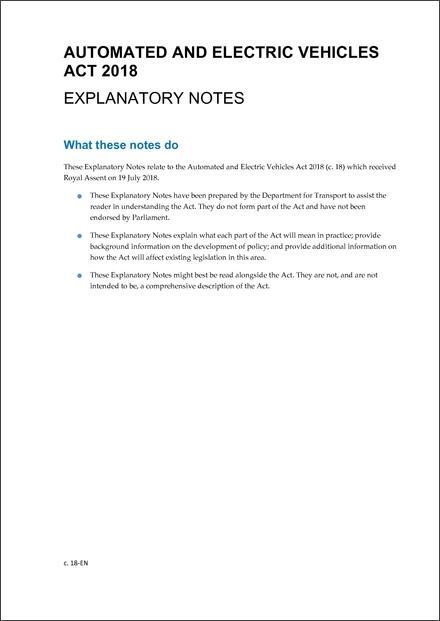
The transition to zero emission vehicles will help us meet our climate change obligations. It will improve air quality in our towns and cities and support economic growth. It will put us at the forefront of the electric vehicle (EV) revolution.
The Automated and Electric Vehicle Act 2018 (AEVA) supports the deployment of world-classEVcharging infrastructure right across in the UK. The powers laid out within the act allow government to regulate, if necessary, to improve the consumer experience of charging infrastructure, to ensure provision at significant strategic locations like motorway service areas (MSAs) and to require that chargepoints have ‘smart’ capability.
In 2019, the government committed the UK to meet net zero greenhouse gas emissions by 2050 to ensure the UK ends its contribution to climate change. Transport is now the largest sector for UK greenhouse gas emissions. Cars and vans alone represent 19% of all domestic emissions. The transition to zero emission vehicles is therefore vital to realising our net zero ambitions.
To achieve this, the government is taking decisive action to end the sale of new petrol and diesel cars and vans, with all vehicles required to have a significant zero emissions capability (for example, plug-in and full hybrids) from 2030 and to be 100% zero emissions from 2035.
This report sets out the work undertaken, in the first reporting period, pursuant to part 2 of theAEVA.
The UK has been a global front runner in supporting the provision of charging infrastructure along with private sector investment. Our vision is to have one of the best infrastructure networks in the world forEVs.
TheAEVAhas 2 parts:
Allowing innovation and ensuring future self-driving (automated) technology is invented, designed and operated safely in the UK. The benefits will be to put the UK at the forefront of automated vehicle ownership and use and maintain our position as one of the best places to research and develop modern transport technologies.
To ensure we retain our position as a global leader in the market forEVsby taking powers to expand and improve our national charging infrastructure. The main benefits of this part are to ensure we have one of the best charging networks in the world, one with convenient infrastructure that is easy to access and ready to support the mass adoption ofEVs.
This report will cover work undertaken relevant to part 2.
TheAEVAgave us the power, through secondary legislation, to:
In spring 2021, we consulted to improve the consumer experience at public chargepoints. We aim to publish the government response in autumn 2021 and lay regulations shortly after.
In summer 2019, we consulted to enable privateEVsmart charging. The government response to this consultation was published in July 2021 and we intend to lay regulations later in 2021.
The consumer experience at chargepoints consultation focused on:
Consumers should be able to rely on their chosen payment method. We proposed that consumers should have a comparably simple payment experience at all chargepoints.
Consumers should be able to pay without the use of a smart phone. This method could be contactless payment, for example, or a call or text-based solution. We sought views on the best way to achieve this that meets consumer needs and is commercially viable.
Roaming will enable consumers to access all public chargepoints with one membership card or smartphone app. We consulted on whether to intervene to provide roaming to the market.
We defined roaming as the ability to use one access or payment method across all chargepoints regardless of the chargepoint operator. We consulted on a range of options to achieve this in the UK. We recognised that this is predominately aimed at fleet operators.
Reliable infrastructure is critical to mass market rollout. It is essential the public chargepoint network is maintained and that faults are repaired quickly.
We consulted on requiring chargepoints be 99% reliable on a fleet average basis across chargepoint operator networks. We proposed a year lead time for any regulations to come into force. We proposed that there be exemptions for events out of operators’ control.

Government has not yet used the powers to require large fuel retailers to provide charging infrastructure. We will continue to monitor the delivery ofEVcharging infrastructure and will use these regulations should we feel that further progress is needed to meet our ambitions.
In March 2020, we published a vision for the future of the rapid charging network in England, which included ambitions for the number of high-powered (150kW+) chargepoints at motorway service areas.
By 2023, we aim to have at least 6 high-powered chargepoints at every motorway service area. By 2030, we expect the network at motorway and major A-road service areas to grow to at least 2,500 high-powered chargepoints, and by 2035 to at least 6,000.
Work to develop the rapid charging fund is ongoing and we expect to publish further information for potential applicants later this year. We may make use of the regulatory powers in section 11 to support the delivery of the fund in the future, though government will first seek to achieve its policy goals through commercial means, to speed up the delivery of the fund and reduce the regulatory burden on the sector.
Government has not received a request from an elected mayor to lay regulations under section 11(1)(a) of the act.
The consumer experience at chargepoints consultation focused on:
All drivers should be able to locate available chargepoints easily. Opening up chargepoint data will enable the development of consumer-friendly apps and improve consumer experience.
We consulted on requiring chargepoint operators to make several data sets available. These datasets included static data such as location, chargepoint speed and payment types, as well as dynamic data such as availability and state of repair. To make the process easier and to encourage good use of the data, we consulted on requiring the Open Charge Point Interface (OCPI) data standard.
We consulted on whether we should mandate that chargepoint operators provide a 24/7 call helpline for consumers so that assistance can be provided to consumers who are struggling to access a chargepoint, for example, if a chargepoint operator’s app is not working correctly on their phone.
We also consulted on working with industry to identify a solution to define ‘available’ and establish the best approach to collecting relevant data where currently this is not openly and readily available. Options could include data collection, self-reporting requirements on chargepoint operators or the introduction of a gold standard certification process.
The consumer experience at pubic chargepoints consultation focused on opening up publicEVchargepoint data to enable consumers to easily locate the chargepoint that suits their needs. We consulted on how we should open up chargepoint data, whether we should mandate a data standard such as theOCPIprotocol and which data we should open up to support our consumer-led outcomes.
Government has also committed to progressing work on private chargepoint data. This work will seek to establish whether the powers under section 14 could be used to require the sharing of private chargepoint data with specified parties, which could include distribution network operators and the electricity system operator.
EVsmart charging involves shifting charging to a different time of day, such as overnight when there is lower demand on the electricity system or to times of high renewable energy generation. This can help reduce the need for costly electricity network reinforcement to meet increased demand fromEVsand offers benefits to consumers too, including savings on their energy bills.
TheEVsmart charging consultation proposed introducing new requirements for all privateEVchargepoints sold or installed in the UK to have smart functionality and comply with minimum device-level standards, using powers under section 15 of theAEVA.
The consultation proposed that chargepoints be required to comply with standards being developed by the British Standards Institution to deliver the main policy principles of cybersecurity, grid stability, interoperability and data protection.
This consultation also included calls for evidence on the government’s long-term approach to smart charging and on the potential sharing of private chargepoint data with network operators.
Following the smart charging consultation in 2019, the government published a summary of responses in May 2020 and a government response and impact assessment in July 2021.
In its response, the government committed to laying secondary legislation under section 15 of theAEVAby the end of 2021 to mandate that private chargepoints sold in Great Britain must be smart and meet minimum device-level requirements.
This secondary legislation will include device-level requirements relating to cyber and data security, grid stability, and safety and monitoring of energy consumption.
The government also set out its intention to continue with a phased approach to smart charging. Parliamentary time allowing, following the laying of this first piece of legislation in the autumn, additional requirements will be developed as part of a second phase of legislation to further mitigate the risks posed by smart charging.
We received over 2,000 responses to the consultation to improve the consumer experience at public chargepoints. We will be publishing our government response in autumn 2021 and with parliamentary time allowing intend to lay legislation shortly after.
Alongside the government response, an impact assessment is being produced to fully assess the cost of policy decisions.
In September 2021, we published the future of transport regulatory review consultation, which includes a section on improving the experience forEVconsumers.
We are proposing new primary powers to build on theAEVAlegislation and ensure that inclusively designed public chargepoints are available for all and that consumers have rights to redress if something goes wrong while charging their vehicle. This consultation will close on 22 November 2021.
As set out in the government response to the smart charging consultation, a second phase of legislation will be necessary to fully mitigate the risks posed by smart charging.
These requirements are expected to go beyond the device-only powers included in theAEVAand would be placed on entities that can control chargepoints, such as chargepoint operators, electricity aggregators and electricity suppliers.
Government also intends to broaden this work to encompass other smart devices and systems, beyondEVsmart chargepoints alone.
The government intends to consult in 2022 on an appropriate regulatory approach to this second phase and will look to take further primary powers beyond theAEVAif necessary.